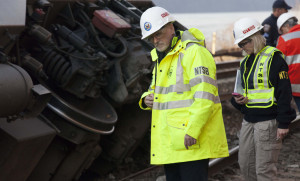Train derailment investigation continues
Federal hearings in Washington to shed light on Metro-North Railroad”™s May 17 derailment that injured 51 and the fatal train strike of a Metro-North track foreman May 28 concluded Nov. 7.
Metro-North put forth a factual defense of its safety culture, which was cited by both the company and by NTSB officials as a world model. The hearings were over less than a month, however, when the New York City Metro-North wreck of Dec. 1 killed four.
While the November hearings have concluded, the NTSB has left open the twin Connecticut investigations and expects to field input on its website over the next several months.
Among the revelations to emerge from the two-day hearings in Washington, D.C., was the scope of different safety procedures, which turn out to be little different than roadway procedures. On one end of the safety spectrum is the “dedicated rail,” where workers are free to make repairs regardless of train traffic. On the other end are flagmen who alert oncoming trains to work ahead.

Incorrectly configured track-blocking devices that allowed trains onto a supposedly closed tracks are eyed as culprits in the May 28 death in West Haven. Metro-North reported that in its history there have been similar instances of misused blocking devices, but none in the last year. The hearing dealt in detail with a 2007 train wreck in Massachusetts that featured a similar track-blocking problem. The circumstances of individual wrecks, however, meant no concrete recommendations came from the Massachusetts accident.
Since the two rail accidents in May, Metro-North officials have implemented several steps to improve infrastructure and safety. But at the hearing officials said the company had fallen behind on maintenance schedules, perhaps leading to faulty repairs at the site of the derailment.
On May 17, two trains carrying a total of roughly 500 passengers collided in Fairfield after one derailed, apparently near a lose rail joint. Six weeks before, inspectors had allegedly discovered broken joint bars at the location and repaired them. But two days before the derailment, inspectors had seen the bars were cracked and are said to have labeled it a low-priority repair.
About 51 people were injured in the crash. Previous reports estimated upward of 75 sought medical treatment.
During the hearings, NTSB officials questioned Metro-North and Department of Transportation officials about inspection and maintenance procedures, operation measures to protect on-track work zones and how the culture of safety surrounding rail could be improved.
One expert witness was Richard Hartley of B&W Pantex L.L.C., which helps manage the nation”™s nuclear repository. “Please look at what other people have done as far as organizational learning and that kind of stuff because I think you would be very, very surprised,” he said. “A lot of the problems you”™re facing right now have been faced before the accident. People have gone through this and actually have some nice little tools out there for that.
“No. 2, I would encourage you guys to explicitly manage your system. Now, I would contend that you operate like a system every day, but I would also contend that most of those systems are in people”™s minds and expert knowledge. You would be aptly surprised if you can find a way to make those things explicit so people can see them ”” and particularly when you start engaging your younger workforce. I would also contend that this is an investment to do it. But I would say also that as you find yourself being safer, your bottom line will improve. All of the things that you cherish will be forthcoming in that.
Of safety culture, Hartley said, “Please don”™t get too enamored by that. I would contend the safety consultation is not the problem. It”™s a good indicator of the work environment, that I would contend is where the resources need to be spent.
“I would like to throw one more look out there: communications,” he said. “There are two parts, a telling part and a listening part. We in the U.S. do very, very poorly on the listening part.
“And the last thing is that I know you guys are very much of a compliance-driven organization or industry,” he said. “I would contend that compliance does not equal safety. There is so much more beyond just being bare minimum requirements. I guess what I have heard a lot is that just because you go home tired doesn”™t mean you”™re safe. So please do the right thing for the right reasons. Engage the workforce. Have them help you understand what the issues are. Again, this bottom-up communications is extremely important because these folks see all of the hazards. They know all of the problems. They”™re the best thing you can get to improve your workforce.”